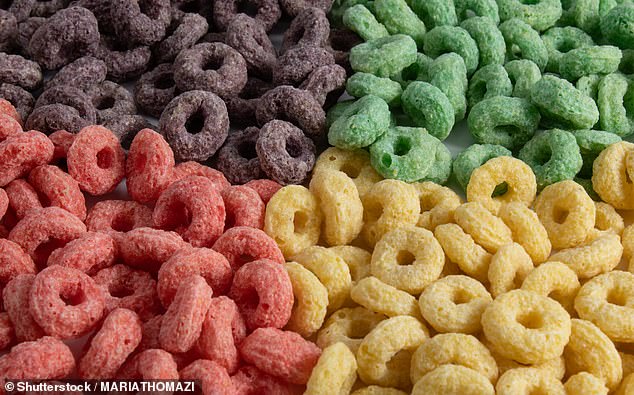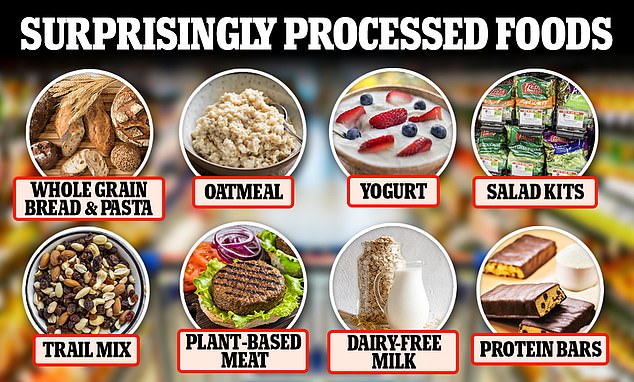Biden’s food advisers could soon urge Americans to avoid chicken nuggets, white bread and cereal as processed foods become the target of a nutritional overhaul
The Biden administration could warn Americans against eating chicken nuggets, white bread and cereal as part of the biggest food advisory shakeup in decades.
Since the 1970s, the federal government has recommended that people avoid foods high in sodium, sugar and saturated fat and eat more vitamins, minerals, fiber and protein.
But a mountain of research in recent years has shown that consuming ultra-processed foods — those packed with artificial flavors, colors, additives and ingredients — can cause a host of chronic conditions.
For the first time, the expert panel that determines what foods Americans eat will examine the science of obesity and ultra-processed foods for the next set of regulations in 2025.
They may advise against staples in the American diet, such as chicken nuggets, sweetened cereals and boxed macaroni and cheese.
DailyMail.com has found that snacks, quick meals and even salad packs can contain up to 120 hard-to-pronounce ingredients, making them ultra-processed

Mountains of research show that eating too many processed foods dramatically increases the risk of premature death, dementia and heart disease
The United States Department of Agriculture (USDA) publishes the Dietary Guidelines for Americans every five years.
The committee is investigating whether eating ultra-processed foods affects ‘growth, size, body composition, the risk of overweight and obesity, and weight loss and maintenance’.
It also asks whether these foods increase the risk of heart disease, type 2 diabetes, cancer, cognitive decline and early death.
These guidelines determine which foods are part of the National School Lunch Program, which serves 30 million American children.
Currently, ultra-processed foods like pizza, Lunchables and Cheez-Its can be found on school lunch menus across the country.
This is because while they are packed with additives, they technically meet government standards for fat, protein, sodium and whole grains.
These regulations also determine which foods are provided as part of government assistance programs and on military bases.

Many foods that are generally considered healthy, such as whole wheat bread and salad packets, are still considered processed
Federal dietary guidelines were first published in 1977 by the U.S. Senate Committee on Nutrition and Human Needs as nutritional goals for the United States.
Key objectives included “preventing obesity,” “increasing consumption of complex carbohydrates and ‘naturally occurring’ sugars,” and “limiting sodium intake by reducing salt intake to approximately 5 grams per day.”
In 1980, this was changed to the Dietary Guidelines for Americans, which outlined seven principles for a healthy diet and recommended limiting sugar, fat, saturated fat, cholesterol and sodium.
Ultra-processed foods have undergone multiple levels of processing and are usually packed with extra hard-to-pronounce fats, colors and preservatives. They target reward systems in the brain, similar to those activated by tobacco products and illicit drugs.
Microwave meals, snack mixes and ice cream are common examples.
These foods have become ubiquitous in the American diet.
a 2022 For example, research from Northeastern University’s Network Science Institute shows that 73 percent of the food supply in the United States is ultra-processed.
And a study published in Limits in nutrition found that more than 60 percent of calorie intake in the US comes from these foods.
Mountains of research have shown that these foods can have harmful health effects.
A 2019 clinical trial by the National Institutes of Health found that when participants were fed a diet of ultra-processed foods, they consumed an additional 500 calories per day and gained weight much faster than when it was mostly unprocessed foods.
A 2022 study published in the journal Neurology found that a 10 percent increase in consumption of ultra-processed foods could increase the risk of dementia.
Moreover, a large cohort study in France, the same increase in ultra-processed foods was found to lead to an increased risk of breast cancer.
A global comparison study published in Obesity Reviews showed that an increase in per capita sales of ultra-processed foods and drinks was associated with a higher body mass index (BMI).
And a few studies by researchers in Spain And France found a link between consuming ultra-processed foods and an increased risk of premature death.
The USDA’s considerations have already sparked backlash from the food industry. More than a dozen food industry trade and lobby groups have written letters to the government, calling on leaders to be cautious with recommendations for ultra-processed foods.
In September, the Institute of Food Technologists wrote that food processing helps “preserve food longer and improve shelf life, minimizing food waste, making it more affordable for consumers because they waste less, and ensuring food and nutrition security when fresh food may not be available.” . available or accessible.’
And a letter from the American Frozen Food Institute said the USDA committee “should not proceed with recommendations on the level of food processing as part of nutritional recommendations.”
At least six other countries have issued guidelines calling on people to cut back on ultra-processed foods. In May, Mexico warned citizens to avoid “ultra-processed foods, such as processed meats and sausages, chips, crackers, cookies, sweet breads and boxed cereals.”
In August, researchers in Britain claimed the country is facing “a tidal wave of damage” from ultra-processed food.
The USDA’s list of considerations states that updated questions will be available when the committee formally begins reviewing the guidelines.
